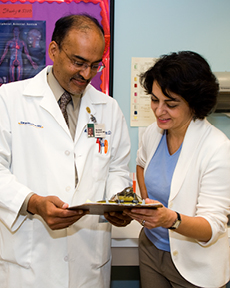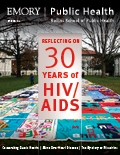Of Heart and Mind
 “If our results are compelling, we hope they will wake up the health community to pay more attention to the emotional factors in cardiac patients.”
“If our results are compelling, we hope they will wake up the health community to pay more attention to the emotional factors in cardiac patients.”
—Cardiovascular epidemiologist Viola Vaccarino
By Robin Tricoles
Viola Vaccarino believes the brain exerts a powerful influence on cardiovascular disease in women
On a wall in Viola Vaccarino’s office hangs a painting of the Temple of Hera, a symbol of her native land, Sicilia. To the temple’s right, a flock of tiny fetus-shaped images float, each tucked safely into an egg-shaped space, all suspended in a mélange of earth tones. When asked about the painting, she smiles and says her daughter painted the piece.

Arshed Quyyumi, Viola Vaccarino, and David Sheps (not pictured) are studying different aspects of mental stress ischemia in a joint project involving the RSPH and Emory School of Medicine. |
Vaccarino, Rollins Professor and chair of the Department of Epidemiology, is an expert on matters of the heart—and the mind. She studies how the brain may rule the heart when it comes to stress and cardiovascular disease, especially among women.
Newly armed with a five-year, $11 million grant from the NIH, Vaccarino and two School of Medicine collaborators are investigating mental stress ischemia, a lack of blood flow to the heart triggered by psychological stress, in three related studies involving up to 650 men and women, all Emory patients with stable coronary heart disease. Led by cardiologist David Sheps, the joint project has its roots in EPICORE—the Emory Program in Cardiovascular Outcomes Research and Epidemiology—directed by Vaccarino.
The joint project builds on work by Vaccarino and Sheps examining the relationship between stress and cardiovascular disease in patients like Antoinae Webb and Barbara Brown. They are among 100 Atlanta-area heart attack survivors taking part in another NIH study in which Vaccarino uses cardiac imaging to examine the effects of a psychological stress test on the heart and then compare the effects between women and men.
A change in pressure
On a Monday in May of last year, Toni Webb felt “a little pressure in her chest” but dismissed it as indigestion.
“The pressure would come and go and last a little longer each day,” she recalls. “On Friday night, I asked my daughter to go online and find out about heart attack symptoms in women. She told me, ‘Mom, you need to go to the doctor.’ ”
The next morning, Webb did just that and was admitted to Emory University Hospital, where cardiologists inserted a stent into one of her arteries, which was severely blocked.
Webb has physical risk factors associated with heart disease. “My father had a bypass at 65 but didn’t make it,” she says. “My brother passed more than a year ago at 53. I have diabetes too.”
She is also under considerable stress. After working in banking for 20 years, she lost her job and is now substitute teaching. Webb has two teenage daughters, and the older is autistic. Her mother lives with them as well.
“Just day-to-day life adds to what’s going on with my health,” says Webb, who is 49.
Like Webb, Barbara Brown struggles with managing stress. And the more stress she’s under, the worse her symptoms become. Now 59, Brown had her first heart attack at 46. It occurred one weekend in the midst of an argument with her husband. She took an aspirin and on Monday drove herself to her primary care physician. After several EKGs, he sent her to the hospital by ambulance where she received a stent.
“But three months later, I knew something really bad was happening,” says Brown. She had experienced chest pain for weeks. The artery at the end of her stent had twisted, which can happen in arteries that tend to spasm. Brown was under a lot of stress when her next heart attack occurred. She had just bought a business and was working nearly 60 hours a week.
It’s not uncommon for those with cardiac disease to have emotional risk factors, says Vaccarino. Several years ago, researchers found that patients with heart disease can suffer from ischemia caused by mental stress rather than physical exertion. The researchers also found that people who carry certain genes may be more susceptible to the effects of mental stress. But whether the path to ischemia is discretely physical or mental, or a combination of both, remains to be seen.
“In previous literature, there’s no correlation between physical and mental stress and cardiovascular disease,” Vaccarino points out. “If you are susceptible to ischemia due to physical stress, you’re not necessarily susceptible to ischemia due to mental stress. It looks like these pathways are completely different.”
Which raises a crucial point: myocardial ischemia brought on by mental stress can prove more dangerous than ischemia brought on by physical stress, says Emory cardiologist and collaborator Arshed Quyyumi. “In essence, mental stress ischemia is associated with worse cardiovascular outcomes in the long run.”
Why me?

Learning to manage the physical and mental stresses in life makes a difference. “I can’t believe it. I’m 59, and I’m heading to graduate school.” |
But why is this so? And why does mental stress ischemia occur in some people and not others? Quyyumi suspects the answer lies in the endothelium, the lining of the blood vessels.
During times of excitement or stress, the adrenal glands secrete hormones that increase heart rate and blood pressure. Increasing heart rate and blood pressure calls for increased blood flow to the heart, which means blood vessels and arteries should dilate to allow blood to flow more freely through the circulatory system. But in some people, this doesn’t happen. The very chemicals that increase heart rate and blood pressure instead cause arteries and blood vessels to constrict.
“The endothelium secretes a variety of different substances that make our blood vessels relax and constrict,” Quyyumi says. “One of the most important is nitric oxide. People who have coronary artery disease have abnormal nitric oxide release in their blood vessels.”
In his study, researchers will measure nitric oxide levels in the brachial artery and also examine arterial stiffness since major arteries can stiffen over time.
“There may be an element of stiffness that accounts for the abnormal reactivity to nitric oxide,” Quyyumi says. “We will measure arterial stiffness to better understand how blood vessel function is associated with ischemia and how it differs in people who develop mental stress-induced ischemia versus those who do not.”
The difference between those who develop mental stress ischemia and those who do not may lie in their genetic variations. Sheps will look at whether study participants with certain genetic markers may be more likely to develop mental stress ischemia.
“Understanding genetic variances that make people more susceptible to stress-induced ischemia could be useful for screening purposes,” says Vaccarino.
In her study, she will investigate what role the brain may play in mental stress ischemia.
“You could have ischemia due to stress because your blood pressure goes up and your heart rate increases. But our hypothesis is that everything happens from here,” says Vaccarino, pointing to her head. “It’s your nervous system, particularly your autonomic nervous system, but also perhaps other areas of the brain that are involved in cognition, perception, and mood. All these areas are connected to the autonomic nervous system and could influence your tendency to have mental stress ischemia.”
To test her hypothesis, study participants will speak on an emotionally charged issue while addressing a frosty audience. Researchers will image the brain before and during the mental stress to see how it responds. Findings in the brain will then be compared with findings in the heart, which will be imaged under a similar mental stress procedure on a different day.
“A PET scan will show changes in the brain caused by mental stress, so particular areas will light up,” Vaccarino explains. “We want to compare people with mental stress ischemia to those without mental stress ischemia and see if different areas of the brain are involved. In particular, we suspect that brain areas involved in mood states such as depression may be affected.”
“If our results are compelling, we hope they will wake up the health community to pay more attention to the emotional factors in cardiac patients,” she adds. “Perhaps in the future, we could devise a standardized psychological stress test to use in clinical practice. That may be our next step—to develop a clinical trial on stress reduction.”
Meanwhile, the women in Vaccarino’s earlier study are faring much better since their heart attacks. Webb exercises, maintains a healthy diet, and is studying for her teaching certificate. Brown, who follows a similar regimen and practices yoga, has lost 30 pounds. She also is headed back to school to earn a master’s degree in community psychology. Learning to manage the mental and physical stresses in her life has made a difference.
“I can’t believe it,” says Brown. “I’m 59, and I’m heading to graduate school.”
|
Online: Watch a video as Viola Vaccarino discusses the relationship between depression and heart disease at bit.ly/heartdepression. |
||||
Shaping Future ScientistsViola Vaccarino stepped into the world of cardiology research as a medical resident in Italy. Convinced that she needed more scientific training, she earned an MPH and a PhD in epidemiology at Yale University. Today at Rollins, Vaccarino ensures that the 200 MPH students and 40 doctoral students who study epidemiology each year are grounded in rigorous scientific methods. “One thing that sets our department apart from other programs is that we provide strong emphasis in methodological skills,” says Vaccarino. “Our graduates know how to design studies, recognize biases, and conduct statistical analyses.” Until last year, Vaccarino served primarily as a professor and cardiology researcher in Emory School of Medicine. As Rollins Professor and epidemiology chair, she strengthens the ties between public health and medicine. Among her goals is increasing the faculty of 30-plus members by 25% to add or expand research expertise in areas such as genetics and cardiovascular disease and provide a broader range of elective courses for students. Whatever their interests, MPH graduates in epidemiology are qualified for public health practice at local, state, national, and international levels. PhD graduates enter academia to continue their research and train future epidemiologists. “Our goal,” says Vaccarino,” is to train students who can influence decisions and policies and put measures in place to prevent disease more effectively.” |
||||

